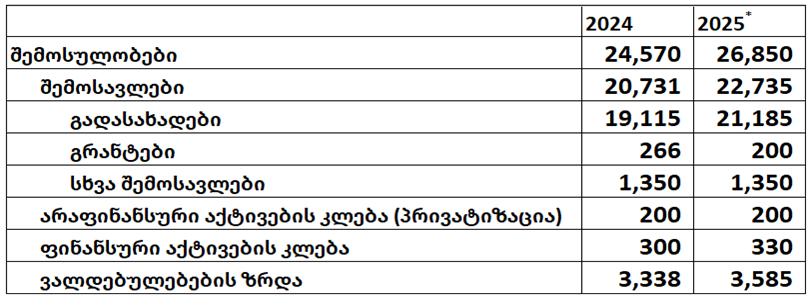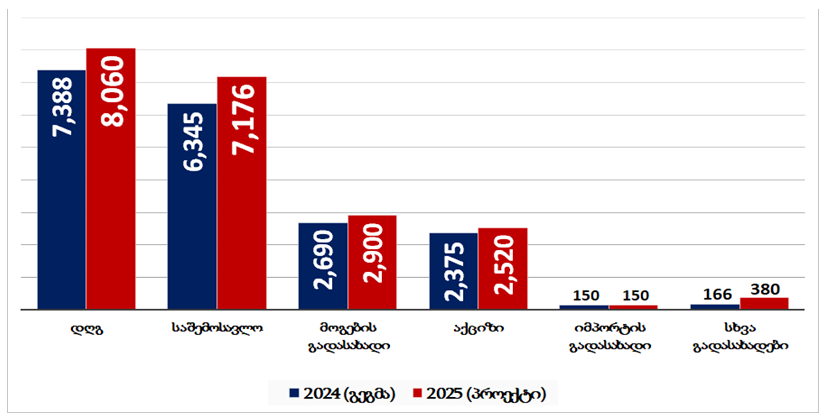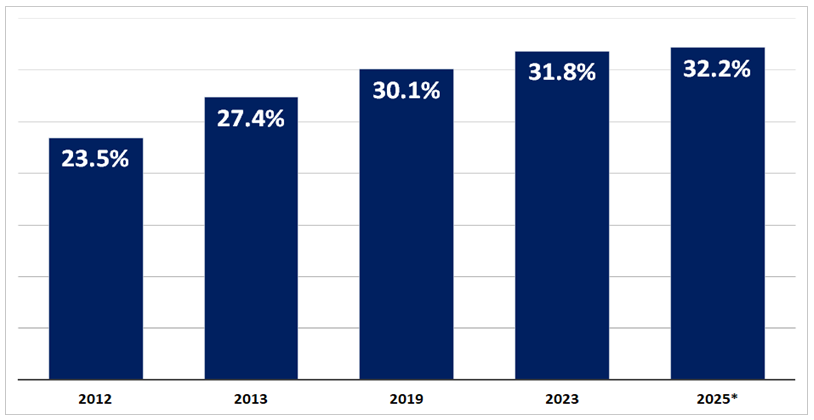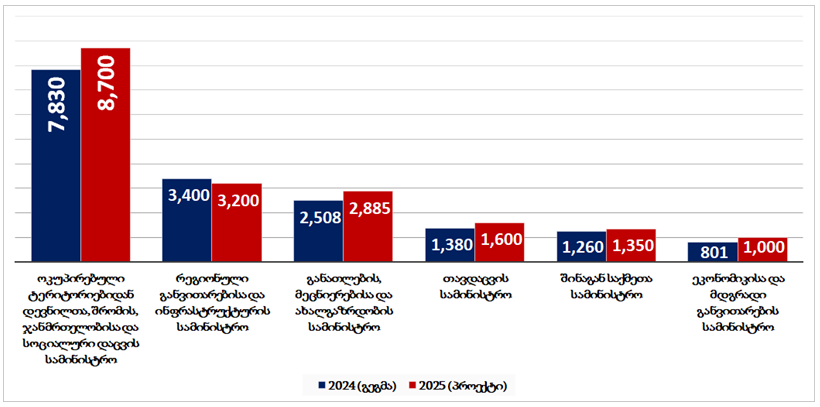The Ministry of Finance presented the initial 2025 state budget to Parliament, projecting a 5.5% growth of the gross domestic product (GDP). The nominal economy is expected to reach GEL 97.4 billion in 2025. Furthermore, the budget deficit remains at 2.5% whilst the government’s debt is expected to decrease to 36.8% of the GDP.
Social initiatives remain a priority as in the previous years. The funds allocated for pension provision will increase by GEL 490 million, reaching GEL 4.4 billion. The monthly pension for individuals under 70 will rise by GEL 20 to GEL 335 whilst pensions for those over 70 will increase by GEL 35, reaching GEL 450. Additionally, pensions for both age groups residing in mountainous regions are going to rise by 20%. The budget for the Universal Health Care Programme is set to increase by GEL 185 million, totalling GEL 1.2 billion. Practically, one-third of the state budget will be allocated to the Ministry of Internally Displaced Persons from the Occupied Territories, Health, Labour and Social Affairs of Georgia.
Total revenues (all income) are set to increase by GEL 2.3 billion to GEL 26.9 billion whilst total expenditures (all spending) will increase by GEL 2 billion, reaching GEL 27 billion, according to the projected 2025 budget. Furthermore, it anticipates GEL 330 million from the decrease of financial assets, exceeding 2024 projections by GEL 30 million. The volume of new obligations is projected to increase by GEL 250 million, reaching a total of GEL 3.6 billion, with GEL 1.6 billion in internal debt and GEL 2 billion in external debt. Internal debt is expected to rise by GEL 100 million whilst external debt will increase by GEL 150 million. The revenue increase is expected to amount to GEL 2 billion, bringing revenues to GEL 22.7 billion.
Table 1: Revenues in the State Budget (GEL Million)

Source: Ministry of Finance of Georgia
The total reduction in grants constitutes GEL 66 million. Whilst some sources are projected to increase, the European Union is set to decrease its grant funding by 93%, reducing it from GEL 105 million to GEL 7 million.
Taxes are anticipated to generate GEL 21.2 billion, constituting 79% of revenues. Income from all types of taxes is set to increase, excluding the import tax.
Graph 1: Projected Revenues from Taxes (GEL Million)

Source: Ministry of Finance of Georgia
Value-added-tax is projected to constitute over 38% of total tax revenues whilst income tax is set to account for more than 33%. The share of import tax remains minimal, contributing less than 1% of total tax revenue, as Georgia has free trade agreements with the European Union, the United Kingdom, China, Turkey and the Commonwealth of Independent States. Property tax is not reflected in the graph above as it is categorised under local taxes and allocated to municipal budgets.
Funding for almost all spending institutions are projected to rise in 2025, including the Parliament (from GEL 87 million to GEL 104 million), the Administration of the Government (from GEL 27 million to GEL 29 million), the State Security Service of Georgia (from GEL 210 million to GEL 226 million) and the Prosecutor’s Office of Georgia (from GEL 63 million to GEL 68 million). Although funding for the Central Election Commission of Georgia (CEC) is decreasing from GEL 171 million to GEL 125 million, it still reflects a GEL 33 million rise as compared to the most recent non-election year. The allocated funding for the remuneration of the 528 employees of the CEC amounted to GEL 19.7 million in 2023; however, the salary budget for the same number of employees is projected to reach GEL 48 million in 2025.
Funding for all ministries is set to increase with the exception of the Ministry of Regional Development and Infrastructure. The Ministry of Internally Displaced Persons from the Occupied Territories, Health, Labour and Social Affairs of Georgia is projected to experience the largest monetary increase amongst all ministries in 2025 with its funding rising from GEL 7.8 billion to GEL 8.7 billion. The funds allocated for pension provision will increase by GEL 500 million, reaching GEL 4.4 billion. Consequently, individuals under 70 will receive GEL 335 instead for GEL 315 whilst individuals 70 and above will receive GEL 450 instead of GEL 415. Additionally, pensions for both age groups residing in mountainous regions are going to rise by 20%, with monthly pensions reaching GEL 402 and GEL 540, respectively. The budget for the Universal Health Care Programme is set to increase by GEL 185 million, totalling GEL 1.2 billion. The funding for providing social assistance is rising by GEL 100 million, bringing its budget to GEL 1.6 billion.
The combined funding for the Ministry of Health and the Ministry of Internally Displaced Persons from the Occupied Territories (these two ministries were separate until 2018) constituted 23.5% of all expenditures in 2012, prior to the government change. This share amounted to 27.4% in 2013, 30.1% in 2019, 31.8% in 2023 and is planned to reach 32.2% according to the 2025 plan.
Graph 2: Share of Funding for the Ministry of Internally Displaced Persons from the Occupied Territories, Health, Labour and Social Affairs in Total Expenditures

Source: Ministry of Finance of Georgia
The relationship between the funding for the aforementioned ministry and the GDP has also been on an upward trajectory. Particularly, this ratio constituted 6.6% in 2012 and is anticipated to reach 9% in 2025. Both analyses demonstrate that social expenditures have been increasing at a higher rate than the economy in the past 12 years.
The second-largest spending institution is the Ministry of Regional Development and Infrastructure. The initial 2025 state budget allocates GEL 3.2 billion to the ministry which is GEL 200 million less than in 2024. This decline is mainly due to the decrease in funding for highway construction. A total of GEL 970 million will be allocated for highway construction in 2025 which is GEL 255 million less than in 2024. In contrast, funding for the reconstruction and rehabilitation of water supply infrastructure is set to rise by GEL 200 million, reaching GEL 747 million.
Funding for the Ministry of Education and Science is set to increase by GEL 377 million, bringing the total to GEL 2.9 billion. This includes a GEL 200 million rise in the funding for general education schools to GEL 1.5 billion, a GEL 30 million rise for professional education establishments to GEL 125 million, GEL 5 million rise for higher education establishments to GEL 171 million and a GEL 8 million rise for science and supporting scientific research activities to GEL 86 million.
The Ministry of Defence ranks fourth amongst spending institutions with GEL 1.6 billion allocated to its budget. Funding for defence management is increasing by GEL 93 million to GEL 657 million, professional military training by GEL 15 million to GEL 106 million, infrastructure development by GEL 60 million to GEL 160 million, defence capabilities by GEL 20 million to GEL 250 million and logistical provision by GEL 22 million to GEL 300 million. Despite these increases, defence expenditures remain below 2% of the GDP which is less than the official NATO standard and lower than the defence expenditures of all four neighbouring countries.
Funding for the Ministry of Internal Affairs will increase by GEL 90 million according to the plan, bringing its total budget to GEL 1.35 billion. The allocation for the development of public order and international cooperation is set to rise by GEL 93 million, reaching GEL 1.056 billion. However, funding for state border protection is decreasing by GEL 11 million to GEL 144 million.
The Ministry of Economy completes the list of ministries that receive funding in GEL billions, with a budget of exactly GEL 1 billion, reflecting an increase of GEL 200 million. A total of GEL 255 million will be allocated for state property management, indicating a GEL 103 million rise, according to the plan. Furthermore, funding for entrepreneurship development will be GEL 287 million which is GEL 18 million less than its previous budget. Innovation and technology development is set to receive an additional GEL 5 million with a total funding of GEL 86 million. The development of power transmission network of system importance is increasing by GEL 24 million to GEL 149 million. A total of GEL 54 million will be allocated to improving the provision of electricity and natural gas to the population, reflecting a more than 15-fold increase from the prior level.
Graph 3: Budget Allocations for Ministries

Source: Ministry of Finance of Georgia
As for the other ministries, funding for the Ministry of Culture and Sport is set to increase by GEL 43 million to GEL 515 million, funding for the Ministry of Environment and Agriculture will rise by GEL 57 million, reaching GEL 745 million; funding for the Ministry of Justice is increasing by GEL 12 million, totalling GEL 427 million; the Ministry of Foreign Affairs will receive an additional GEL 12 million, bringing its total funding to GEL 200 million; the Ministry of Finance’s budget will increase by GEL 7 million, reaching GEL 121 million.
Amongst other spending institutions, the Georgian Intelligence Service will receive GEL 24 million, reflecting a GEL 3 million rise; funding for the Special State Protection Service of Georgia will rise by GEL 6 million, reaching GEL 108 million; the co-funding for the Funded Pension Scheme will increase from GEL 430 million to GEL 480 million. The Contingency Fund of the Government will remain at GEL 90 million. Furthermore, funding for the Patriarchate of Georgia and the Public Broadcaster will also remain the same as before – at GEL 25 million and GEL 101 million, respectively.
Parliament must approve the budget by the third Friday of December. Costs typically rise during the second and third rounds of adjustments, based on past experience. The revisions may be more extensive and priorities may be redistributed in case of a change in government.







